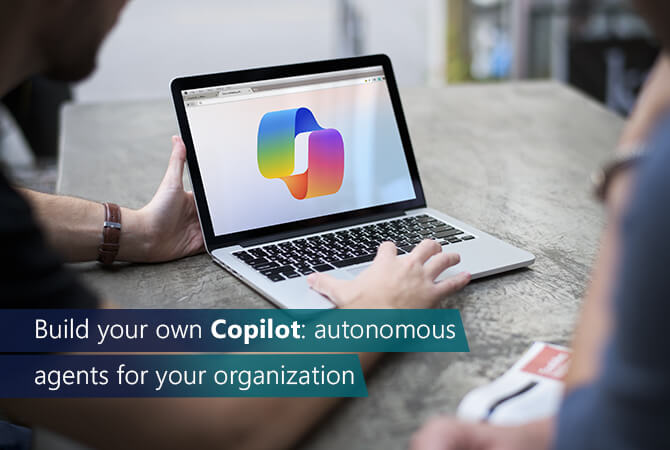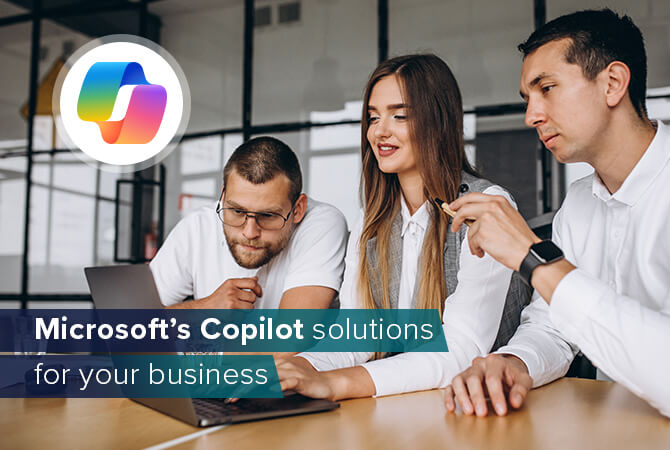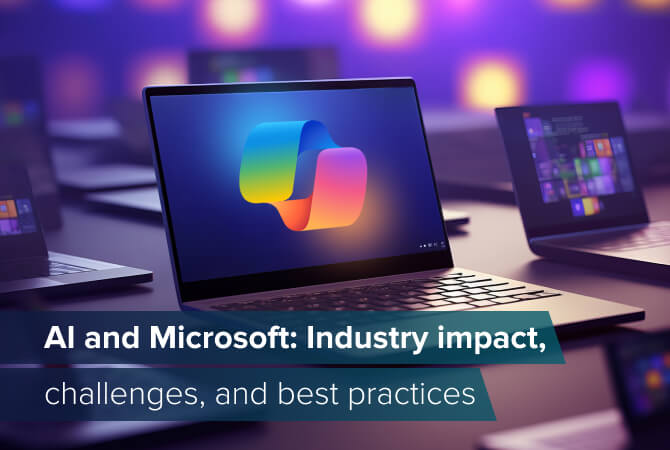
AI and Microsoft: Industry impact, challenges, and best practices
Content
We live in an era of information, where large amounts of data, numbers, and figures flood our minds daily. This can sometimes overwhelm the human brain, leading to burnout. However, the introduction of ChatGPT to the public back in 2022 kickstarted a new way to deal with that problem. It quickly processes vast amounts of data, extracting relevant insights, and presenting them in a digestible format. That was the moment when the world saw the potential behind AI and the endless capabilities it had to offer in all sorts of industries, from creative writing to managing projects.
In this article, we will focus on the benefits of AI implementation across various environments, the challenges that may arise, and the best practices to overcome said challenges and enhance your business system efficiency.
Industry-specific applications of AI and Microsoft products
Thanks to its early strategic investment in OpenAI and the development of its own AI technologies, Microsoft has positioned itself at the forefront of the AI revolution. The tech giant has introduced tools that have already transformed industries such as manufacturing, transportation, finance, healthcare, and more.
Generative AI demonstrates a remarkable $3.7 return on investment for every $1 spent, with deployments delivering value often within 13 months. Let us now take a closer look at its practical applications along with various Microsoft products and the results achieved by different businesses.
AI in manufacturing
One of the largest industrial manufacturing companies in Europe, Siemens, has been using various AI tools and had already established defined processes for developing them. However, they found themselves reinventing a wheel every time they began the development of a new AI model. Siemens IT had to write thousands of lines of code from scratch, which kept all the new ideas in production for months. This was when Siemens took the initiative and created a platform designed for developing AI models, which is fully based on Microsoft Azure.
Azure allows for the creation of AI models automatically, which makes the whole process a lot faster and cuts the development time from several months to a few weeks. According to the IT Principal Key Expert Data Analytics & AI at Siemens, the team switched from writing new code every time to reusing the assets repeatedly. This approach ensures that the components are already well-tested, and anyone can jump into the development process right away. Moreover, the company needed at least three data analysts to maintain the code in a healthy state. Azure allows them to reduce that number to just one individual.

AI in transportation and logistics
What can AI do for the transportation industry? AGMC, the exclusive BMW Group importer for Dubai, Sharjah, and the Northern Emirates, knows the exact answer. Having been dedicated to its customers for over 47 years now, the company has developed a massive operation: They receive and deliver between 120 and 140 cars every single day. Previously, this required hours of tedious manual work for locating cars on the premises spread across more than 10 parking zones.
To address the issue, AGMC collaborated with Pulses.ai to launch Sphere 360, an AI-driven solution built on Microsoft Azure. It uses 56 specialized AI cameras to track cars. This system significantly speeds up the process of locating cars, reducing customer wait times and improving satisfaction. The AI cameras, equipped with five AI models each, ensure efficient image capture and accurate license plate recognition, even in extreme weather conditions. The solution also integrates with Microsoft 365, allowing staff to monitor car repair stages and receive alerts for any delays.
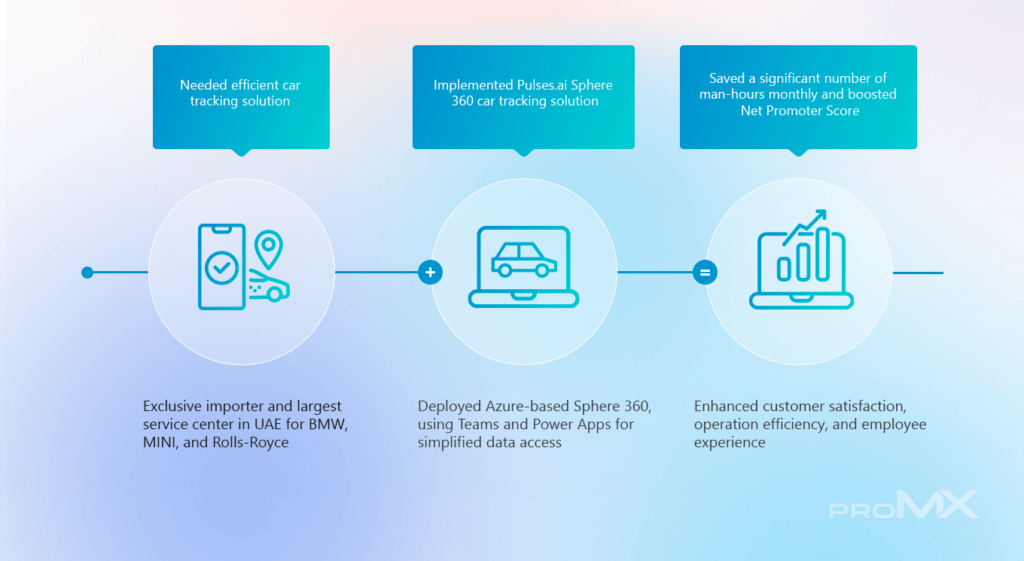
AI in finance
Being the UK’s number one platform for private investors, Hargreaves Lansdown strives to provide their customers with the best experience. Thus, adopting new technology like Microsoft Copilot for Microsoft 365 was an easy decision to make on the spot. And it didn’t take too long to pay off. In just two weeks, the team mastered the capabilities of Copilot, which allowed them to:

AI in energy
Digital transformation is one of the pillars that make the shift from a centralized to a decentralized energy supply possible. The future of energy supply lies within smart IT infrastructure, digital management of power grids, and intelligent collaboration tools. Modern energy providers such as E.ON opt for the tools that make the future possible. For instance, they use Microsoft 365 to create presentations, infographics, and to amalgamate data when needed.
Moreover, taking part in the early access program (EAP) for Copilot for Microsoft 365 allowed E.ON to identify three main use cases for this tool:
- Assisting with routine work tasks
- Transcribing and minuting Teams meetings
- Locating files, chats, and emails via the Microsoft 365 Copilot chat
From a practical perspective, Copilot can help employees comb through huge amounts of data to find the relevant facts and figures. This is particularly useful when a task calls for less frequently used sources.

AI in healthcare
Artificial intelligence, teamed up with Microsoft products, has advanced so far that it helps humanity fight cancer within Geninus, a leading Korean company in precision healthcare.
CancerSCAN is one of their groundbreaking products that offers high-sensitivity cancer genetic diagnosis. The service must analyze the genomes of patients to find the best medicine for their particular case. However, the amount data to process is overwhelming: analyzing the genome of just one person can generate up to 100 GB. Such intensive computing tasks required powerful solutions, and Microsoft Azure Batch technology was there to provide. After utilizing the cloud for genome sequencing, Geninus was able to focus on its core activities and let those with expertise handle infrastructure operations.
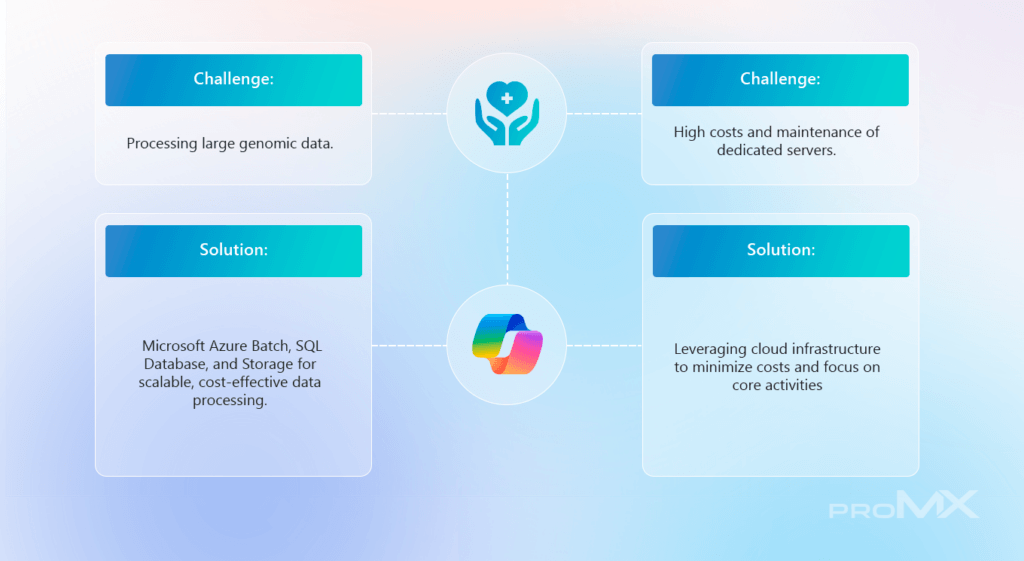
Challenges in AI adoption
As we have already established, AI implementation can do wonders for a business. However, the process of implementation requires careful preparation. In this section, we will discuss the most common issues and concerns that might arise during the AI transformation so that you are forewarned and, therefore, forearmed.
Integration with existing systems and processes
One of the most frequently asked questions before embarking on an AI implementation journey is whether the already existing system is going to take the intruder well.
For instance, many organizations rely on older systems that do their job perfectly well but may not be compatible with new AI technologies. Additionally, the data within a company can be scattered across various departments. This situation can be challenging not only for AI algorithms but also for new employees who do not know where to look for the information they need. And even if everything is ready for the integration of new technology technical-wise, it will take some time for your employees to get used to the new processes.
Workforce training
Just like anything new, adopting AI requires training. As mentioned, the technical aspect is not the only thing that might require your attention. Even though many employees will need to fill in the skill gaps, you should also keep in mind the human factor and the resistance to change due to fears of job displacement or feeling incompetent.
According to a study conducted by Slack in 2024, 76 % of workers felt the urgency to become AI experts, but only 33 % of them actually adopted AI in their everyday activities. There were several reasons for such an outcome: Some felt that using AI felt like cheating, and some feared being seen as lazy or incompetent for their position. Taking this into account, organizations not only need to invest in comprehensive training programs to upskill the workforce but also address their concerns along the way.
Data privacy and security
The last but not the least concern is security. AI systems usually require access to the company’s databases. This includes letting AI “see” all the sensitive personal information, which might lead to privacy issues if not handled correctly. Therefore, you must navigate complex regulations to ensure data privacy.
Microsoft prioritizes security. This is why Copilot complies with established privacy and security standards, including General Data Protection Regulation (GDPR) and the EU Data Boundary requirements. Prompts, responses, and data accessed through Microsoft Graph are not used to train foundation LLMs. Copilot is designed with multiple layers of protection. It blocks harmful content, detects protected material, and prevents prompt injections (the attacks where harmful inputs are added to an AI’s prompt, causing it to give wrong or harmful responses).
Additionally, Copilot ensures that results for a user include only data they are authorized to access, so you don’t have to worry about it disclosing the information you did not intend to disclose. In other words, a backend developer will not see sensitive HR data in the results.
How to integrate AI into existing technology in 8 steps
Now that we have talked about some of the most common pitfalls you might encounter on the way to AI implementation, let us shift our attention from “what-ifs” to “how-tos”. Let us create a step-by-step AI implementation plan that takes into account everything we have already discussed in this article.
1. Set a goal
To begin with, it is important to set a clear purpose. Ask yourself, what exactly would you like AI to improve in your business? Consider the expected outcomes and benefits that would not be possible without the upgrade.

2. Analyze the existing system
The next step would be to get to know the system you are currently working with in depth. If you truly understand the source code, it will be way easier to predict its behavior when something new is introduced.

3. Identify the data sources
Any AI model needs vast amounts of data to train and learn the ways of your organization to become a valuable part of it. This can include internal and external data sources alike, be it customer data, sales data, social media data, etc. Therefore, in order to make sure the AI is well-trained, you need to conduct a thorough data analysis, evaluate its quality, completeness, and relevance to your specific goal:
- Consolidate siloed sources into centralized, shareable data lakes.
- Cleanse, label, and format data consistently.
- Build internal data exchanges that automatically share data changes across systems in real time.
- Establish data governance protocols covering security, access permissions, and curation processes.
- Find ethically sourced third-party data to fill any critical voids in internal data.

4. Select a storage option
Storage is another thing that should not be overlooked in the AI integration process. The system that stores, processes, and analyzes data should easily connect with AI using APIs and have enough space to handle large amounts of data. Depending on the preferred costs, control preferences, tool availability, latency tolerance, and scalability needs, you can choose an option that works best for you:
- Data lakes offer affordable, unlimited storage capacity for collecting diverse data prior to organizing it.
- Data warehouses support comprehensive analytics and business intelligence for the data that has already been organized.
- Data marts provide targeted analytics on pertinent, processed data tailored for particular teams.
- Hybrid cloud deployments mix cloud and on-site servers.

5. Ensure ethical and legal compliance
Any AI system is going to work side-by-side with people. This means that it has to follow the same rules as everybody else: operate fairly, securely, and transparently. In practice, this requires:
- Regularly checking AI algorithms to make sure they are free of bias.
- Adding features that help users understand how AI makes decisions.
- Implementing strict rules and security measures to manage and protect sensitive data.
- Promoting responsible AI usage across your organization.

6. Select the Large Language Model (LLM) that works best for you
Once you have established clear goals, improved the data quality, and prepared a solid infrastructure, you can decide which of the existing forms of AI meets your strategic needs: a simple and transparent model or a more advanced deep learning neural network. Besides, if your approach requires a more personal touch, there is always the option to replace a single global model with a Mixture of Experts (MOE).

7. Train employees
As mentioned, adjusting your employees to the new environment is one of the main steps to be taken during the AI implementation. Besides basic technical training, they will need to do more than just use the new technology in the same processes as before. The employees must transform their understanding of problem-solving and their overall approach to work:
- Take on new responsibilities as AI handles the old routines.
- Use AI-generated insights wisely to make their own decisions.
- Refresh job-specific skills to pivot towards more strategic initiatives.
- Learn the fundamentals of effective communication with AI.

8. Integrate AI
Having completed the previous seven steps, you are ready for the final boss: AI implementation and testing:
- Add AI to secondary systems first to reduce risks if problems arise.
- Monitor performance, accuracy, speed, usage rates, and user feedback.
- Test with small data samples and user groups to improve functionality.
- Quickly make necessary changes along the way based on the evolving needs.

How to measure the success of artificial intelligence implementation
Let’s say you have successfully prepared your company for the AI shift, trained your employees, developed and integrated a perfect solution for your business, complied with legal and ethical requirements, and have been using AI for some time now. How do you know you made the right decision, and how do you measure the success of the implementation? The below table will provide you with an idea of what to look for:
| Business value | Customer satisfaction | Model performance | Feedback |
|---|---|---|---|
| Check if the revenues increase over time, the opportunities grow, risks are reduced, and overall productivity and efficiency are improved. | Conduct surveys and gather feedback to see whether the customers find the AI experience helpful, efficient, and personalized. | Track if your AI model makes accurate predictions and gives precise recommendations. | Gather feedback from employees who interact with the AI system on how it affects their productivity and daily workflow. |
| Operational efficiency | Analytics/telemetry | Data quality | A/B testing |
| Keep an eye on the gains from automated tasks, reduced errors, and streamlined processes. | Monitor how customers interact with the AI system. Measure click-through rates, chat session lengths, and use of specific features. | Monitor data quality, accuracy, completeness, and representativeness against your target audiences or business objectives. | Compare different versions of your AI model or user interface to see which one performs better with customers. |
Conclusion
Across every industry, AI is creating a fundamental shift in what’s possible, enabling new use cases and driving business outcomes. While organizations around the world recognize the value and potential of AI, for it to be truly effective, it must be tailored to specific industry needs.
If you find yourself in need of assistance, proMX is always happy to provide. Our implementation services do not end with the implementation itself. We offer additional development to keep your AI system always aligned with your agile business! Feel free to contact us if you have any questions!



